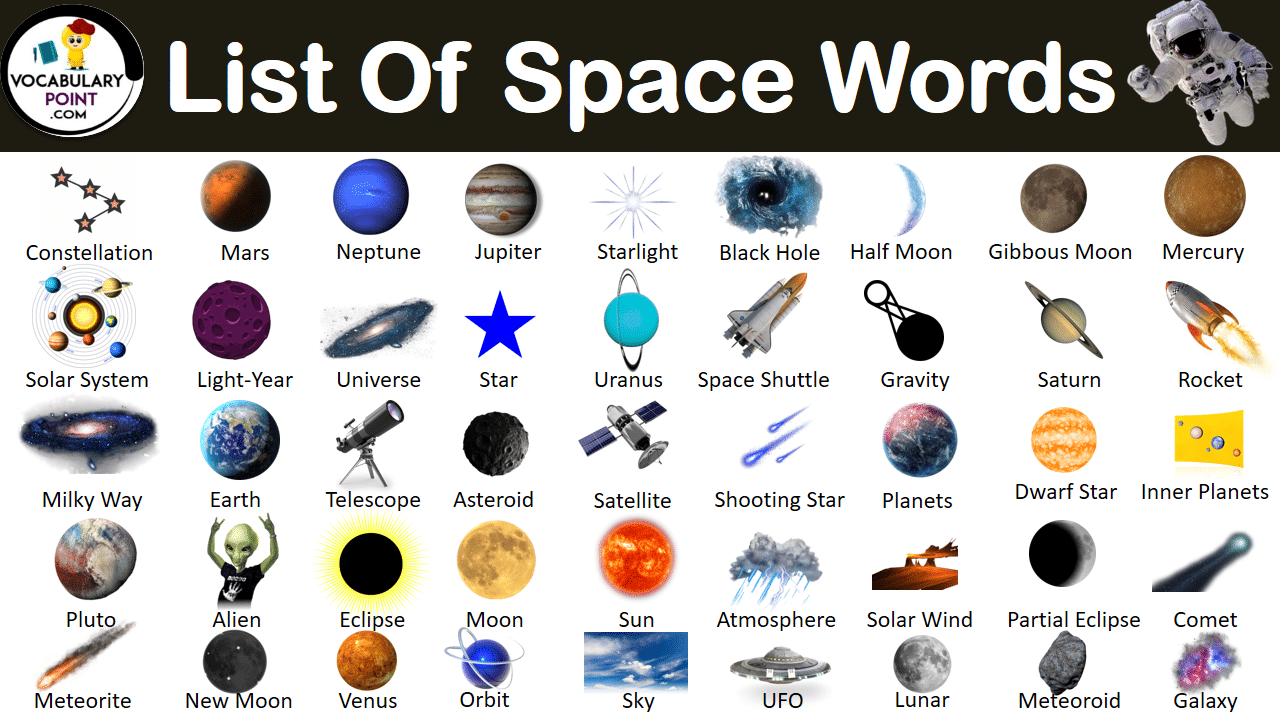List of Space Words. Space exploration has been a source of fascination for centuries, with mankind continually striving to reach the stars. To help with this ongoing quest, scientists and engineers have developed a specialized vocabulary filled with words that are unique to space exploration. Whether you’re looking to understand a news article about the latest space mission or want to learn more about space exploration in general, having a firm grasp on these terms is essential.
Must Learn: Vocabulary word with picture
Definition of Space?
Space is the vast expanse that exists beyond Earth’s atmosphere, extending outward to the edge of the universe. It is characterized by the absence of matter and the presence of a vacuum, which makes it a hostile environment for life as we know it.
What are space words?
Space words are terms and vocabulary related to the study and exploration of space. These include terms related to astronomy, astrophysics, space exploration, and space technology. Some examples of space words are:
Must Read: Business Phrasal Verbs
Planets:
- Mercury
- Venus
- Earth
- Mars
- Jupiter
- Saturn
- Uranus
- Neptune
- Pluto (optional)
Stars:
- Sun
- Red Giant
- White Dwarf
- Black Hole
- Supernova
Spacecraft:
- Space Shuttle
- Rocket
- Satellite
- Space Station
- Mars Rover
Space Exploration:
- Astronaut
- Moon Landing
- Spacewalk
- Mission Control
- Interstellar Travel
Space Objects:
- Meteor
- Comet
- Asteroid
- Nebula
- Galaxy
List of Space Words
- Astronomy
- Astrophysics
- Galaxy
- Universe
- Planet
- Star
- Solar System
- Comet
- Asteroid
- Meteoroid
- Nebula
- Black Hole
- Wormhole
- Satellite
- Spacecraft
- Astronaut
- Cosmonaut
- Rocket
- Space Station
- Gravity
- Orbit
- Telescope
- Celestial
- Extraterrestrial
- Constellation
- Lunar
- Martian
- Interstellar
- Exoplanet
- Gravity
- Spacewalk
- Telescope
- Space Shuttle
- Space Exploration
- Hubble Space Telescope
- International Space Station
- Space Junk
- Space Debris
- Dark Matter
- Space-time
- Space Race
- Space Weather
- Space Tourism
- Space Elevator
- Spacewalk
- Microgravity
- Ion Thruster
- Escape Velocity
- Space Colony
- Space Probe
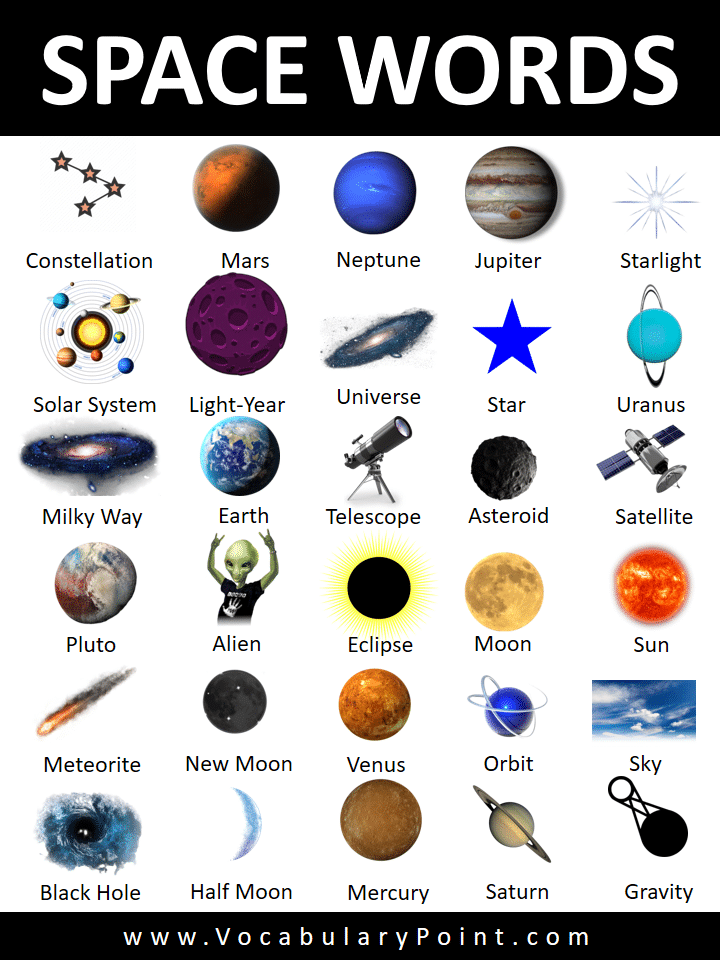
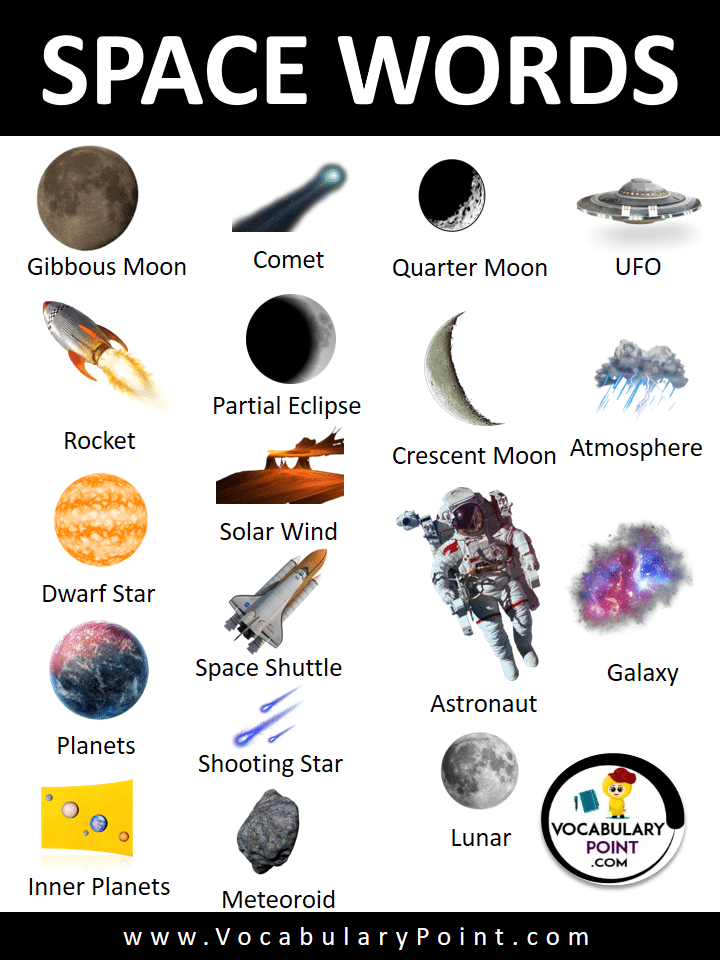
Cool Space Terms
Constellation

The night sky is a beautiful and awe-inspiring sight, made up of millions of stars weaving together in unique patterns known as constellations. Since ancient times, constellations have held a special place in the hearts of people from all around the world.
Solar System
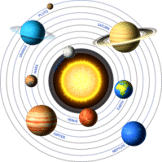
As humans, we have always been fascinated by the night sky and the stars that make up our universe. For centuries, astronomers have studied and observed the planets, moons, asteroids and comets that make up our solar system.
Milky Way

The Milky Way is a vast, beautiful, and mysterious place that has fascinated people for centuries. It is the galaxy we call home, and its history and secrets are still being discovered today. From the stars that light up our night sky to the planets orbiting our Sun, the Milky Way holds many wonders.
Pluto
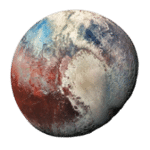
Pluto, once known as the ninth planet of the Solar System, has long been a source of fascination and debate among astronomers. The Pluto debate began in 1930 when Clyde Tombaugh discovered the celestial body during his search for Planet X.
Meteorite

Meteorites have fascinated people for centuries, often inspiring awe and wonder. These rocks from outer space, ranging in size from microscopic dust to large boulders, are pieces of the solar system that we can hold in our hands.
Black Hole

Black holes have been a source of fascination for scientists and laypeople alike since their discovery over two centuries ago. These celestial objects are mysterious, powerful and awe-inspiring.
Mars
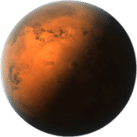
Space exploration has been a fascination for centuries, and the red planet of Mars has held a particular allure for scientists and adventurers alike. Ever since the first spacecraft voyaged to Mars in 1965, humans have been captivated by the idea that life may exist on this distant world.
Light-Year

Light-year is a unit of measurement that denotes the distance traveled by light in a vacuum in one year. It has become an integral part of astronomy and astrophysics as it allows us to measure the vastness of space.
Earth

Earth is the third planet from the sun and the only object in our solar system known to harbor life. It is a unique planet, with many features that have allowed it to sustain life for billions of years. Earth’s atmosphere, oceans, landmasses and biodiversity are all essential components of its ability to sustain life and make it an awe-inspiring place to live.
Alien

The topic of alien life has captured the public imagination for centuries. From ancient stories and myths to modern science fiction, these extraterrestrial creatures have been a source of curiosity and fascination.
New Moon

The new moon is a beautiful and awe-inspiring sight that has captivated people for centuries. Every month, the new moon brings night skies filled with mystery and possibilities.
Half Moon

The night sky is full of stunning sights, and one of the most iconic is the half moon. This celestial object has been a source of wonder and fascination for millennia, with its gentle curves and soft light.
Neptune

As the eighth and farthest planet from our sun, Neptune has long been a source of fascination. This gas giant is known for its vibrant blue color, which is caused by the methane in its atmosphere. Its unique features have made it one of the most interesting planets in our solar system.
Universe

The vastness of the universe is awe-inspiring, and it has been the subject of fascination for centuries. From the stars in the night sky to galaxies far away, our universe is filled with wonders that have piqued our curiosity and inspired a great deal of exploration and research.
Telescope

n the past four centuries, the telescope has proven to be a revolutionary tool for exploring and understanding our universe. It has enabled us to observe star formation, distant galaxies, and other phenomena beyond our own planet.
Eclipse

For centuries, humans have been captivated by the majestic beauty of a solar eclipse. This phenomenon is a cosmic ballet where earth and space collide in perfect harmony. During a total solar eclipse, the sun’s disk is entirely covered by the moon and day becomes night for a brief period.
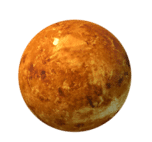
The planet Venus is one of the most mysterious and fascinating worlds in our Solar System. It is often called Earth’s sister planet, being very similar in size, composition, and distance from the sun.
Mercury

Mercury is the closest planet to the Sun and has been studied for centuries by astronomers. It is the smallest of all planets in our Solar System, yet its unique characteristics have allowed us to gain valuable insights into our Solar System and beyond.
Jupiter

Jupiter is the largest planet in our Solar System and has captivated mankind for centuries. From its mysterious red spot to its many moons, Jupiter is a fascinating celestial body. It is the fifth planet from the Sun and was named after the Roman god Jupiter, who was also known as Zeus in Greek mythology.
Star

The night sky is filled with stars that have been here since long before us and will remain after we are gone. The star, while seemingly a single object, is actually made up of many complex parts and elements. A star is composed of gas and dust, held together by its immense gravity.
Asteroid

Asteroids have long been a source of intrigue and fascination for humankind, from the earliest ancient observations to today’s sophisticated technologies. They are remnants left over from the formation of our solar system about 4.5 billion years ago, and hold clues to its past as well as potential resources for the future.
Moon
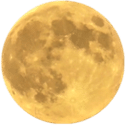
The Moon has captivated the human race since ancient times. Its luminescent presence in the night sky has inspired awe, curiosity, and a sense of wonder. Different cultures have their own special stories and beliefs associated with the moon.
Orbit

The mysteries of space have always captivated humankind. The concept of orbit has been studied for centuries and is one of the most important concepts in space exploration. It is the path an object, such as a planet or a satellite, takes around another object due to gravitational forces.
Saturn
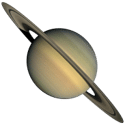
Saturn is one of the most fascinating planets in our Solar System. It stands out for its stunning rings, which have captivated astronomers and general observers alike for centuries. Not only does Saturn possess a unique beauty, it also offers us a glimpse into the mysteries of space and our universe.
Starlight

Stars have always captivated and inspired us. From constellations to the nightly sky, starlight has lit up the night for centuries and has been a source of fascination and fantasy.
Uranus

Uranus, the seventh planet from our sun, is one of the most fascinating celestial bodies in our solar system. It was discovered by William Herschel in 1781 and is largely composed of an atmosphere of hydrogen and helium.
Satellite

Satellites have dramatically changed our lives in the 21st century, giving us access to satellite-based navigation, communications and data services. They are now an essential part of modern life and our day-to-day activities.
Sun
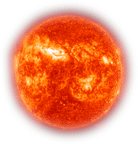
The Sun is the star at the center of our Solar System and an essential part of life on Earth. It has been around for billions of years, providing heat and light that makes it possible for us to exist.
Sky

The sky is one of the most captivating aspects of nature. It has been an object of fascination for centuries, inspiring awe and wonder in all who gaze upon it.
Gravity

Gravity is one of the fundamental forces of nature. It is an invisible force that affects all objects on Earth, and plays an essential role in many everyday phenomena. It is the force that holds us to the ground, keeps the moon orbiting around Earth, and prevents us from floating away into space.
Gibbous Moon
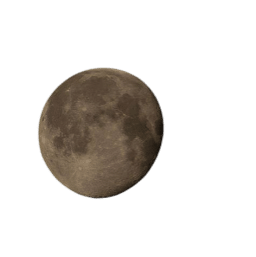
The gibbous moon has been a source of fascination for centuries, inspiring stories, artwork, and even scientific inquiry. As the middle phase of the lunar cycle, the moon’s gibbous phase is visible for several days at a time and marks a time of transition between fullness and waning.
Rocket

Rocket is an incredible form of transportation that has changed the way we view space exploration. This innovative technology has enabled humanity to explore further than ever before, and it is only getting better.
Dwarf Star
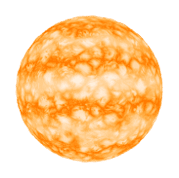
Dwarf stars are some of the most fascinating celestial objects in our universe. They are incredibly small and dense, yet they generate enormous amounts of energy. Dwarf stars come in many varieties, and they are believed to be among the oldest stars in existence.
Planets

The planets in our solar system are fascinating, mysterious, and captivating. They have been studied for centuries, with new discoveries being made every day. From Mercury to Neptune, each of the eight planets has a unique set of characteristics and features that make them stand out from one another.
Inner Planets

Our solar system is made up of eight planets, four of which make up the inner planets. These inner planets are Mercury, Venus, Earth and Mars. From the Sun outwards, these planets are the closest to our star and are separated from the outer planets by a band of asteroids known as the asteroid belt.
Comet

Comets have captivated sky watchers for centuries. These icy bodies, made up of a mix of dust and frozen gases, travel in highly elongated orbits around the Sun. They are believed to be remnants of material left over from the formation of our Solar System some 4.5 billion years ago.
Partial Eclipse

A partial eclipse is a unique and awe-inspiring natural event that occurs when the moon passes between the sun and Earth. During a partial eclipse, the moon blocks some but not all of the sun’s light from reaching Earth, creating an incredible sight in the sky.
Solar Wind

The sun is a powerful source of energy, and scientists have long been researching ways to capture its power. Solar wind is one method of capturing solar energy and converting it into usable electricity.
Space Shuttle
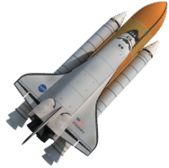
The space shuttle was a revolutionary invention that forever changed the way humans interact with space exploration. Developed in the 1970s, the space shuttle was a reusable spacecraft that made numerous trips to and from Earth orbit.
Cool Space Terms
Shooting Star
The sight of a shooting star is one that many people have stopped to marvel at, and the fascination remains strong today. While the stars are made of dust and gas particles, they often appear to be burning with an intense glow as they streak across the night sky.
Atmosphere

Atmosphere is a term used to describe the envelope of gases that surrounds our planet. It is composed of numerous elements, including nitrogen and oxygen, which are essential for life on Earth. Without this layer of protective gas, the world would be a very different place.
Galaxy

The universe is an ever-expanding mystery, and one of the most fascinating phenomena in it are galaxies. A galaxy is a huge collection of dust, gas, and billions of stars bound together by gravity. Galaxies come in various shapes and sizes and can be found across the entire observable universe.
Meteoroid

Meteoroids are small pieces of extraterrestrial material that can be found in space. They originate from asteroids, comets, and other similarly sized objects from beyond our planet’s atmosphere.
Lunar
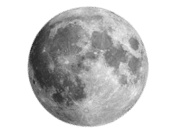
The moon has captivated humanity since the dawn of time. Its mysterious beauty and constant presence in the night sky make it an enduring fascination. From ancient times to modern day, people around the world have been amazed by its phases, movement, and brightness.
UFO

For centuries, people have reported strange sightings in the sky that can’t be explained by conventional means. From stories of flying saucers to tales of alien visitations, the existence of UFO’s has remained an elusive and mysterious phenomenon.
Quarter Moon

The quarter moon is an awe-inspiring celestial phenomenon that has held a special place in human mythology and culture for centuries, captivating the attention of skywatchers all over the world.
Crescent Moon

The crescent moon is one of the most recognizable symbols in the night sky. It is a universal symbol that has been embraced by cultures across the world and throughout history.
Astronaut
The iconic figure of the astronaut is one that has long been held in awe and admiration. From the first human spaceflight by Yuri Gagarin to modern-day missions, these brave individuals who venture into the unknown have pushed back the boundaries of our knowledge and exploration.

